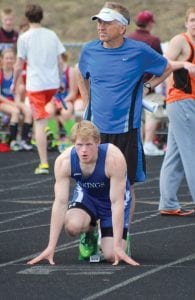With Coach Chris Hegg standing on his blocks, Peter Warren got set to practice his start before the 100-meter race at the State Meet held Friday and Saturday, June 7 and 8 at Hamline. Warren also qualified in the 400 meter run and ran under 51 seconds but failed to advance to the finals in either the 100- or 400-meter runs although he ran extremely well, earning lifetime bests.

We headed down to the Minnesota High School League State Track and Field Championships on Friday, June 7 at Hamline University in St. Paul. As reported last week, senior sprinter Peter Warren had qualified for the 100-meter and 400-meter dashes at the Section 7A finals. It has been two years since Viking stars Ailee Larson, Kieran Scannell and Molly Zafft qualified for State, Ailee and Kieran for the second time. You have to go back 20 years to find the next most recent qualifiers. Although we are not at the level of the glory years for Viking Track in the 1970s, we are rewriting some of their all-time school records.
It was a perfect day for track, overcast, 70s and no wind. There was an aura of excitement in the air that only a State meet can generate. With all that excitement, we were a little worried that Peter would use all his energy up before his first race. As he worked through warm-ups however, he settled into his normal pre-race routine.
To qualify for Saturday’s finals, you had to record one of the top nine times in Friday’s preliminary rounds. Although Peter did not have one of the top qualifying times in either event, we knew that would not dent his confidence, nor would it stop him from giving it his best shot. He had been working hard for five years to get here, and he planned to leave it all on the track. First up was the 100-meter dash.
As we settled into our seats at about the 70-meter line, Peter settled into the blocks at the starter’s command. At the crack of the gun, we could see he was off to a good start.
At about 30 meters, he transitioned well out of the drive phase (where the runner has his head down and a slight forward lean for better acceleration) and was in full sprint. As he went by us at 70 meters however, we could see the superior speed of the top runners had left him in the back half of the field. After he finished, we waited impatiently as they posted the overall results.
Peter had a very good time of 11.44, second only to his wind-aided 11.31 at Sections. Unfortunately, he finished 14th in the 18 runner field and would not move on to the finals. The 400 would start in about an hour.
Peter had drawn lane 1 for his heat of the 400. It was a pretty good draw, since he could see all the runners staggered ahead of him in the outer lanes. His strategy was to get out hard, move smoothly into a pace just below all-out sprint, and keep an eye on the runner next to him in lane 2, the number 9 overall qualifier. Charging out of the blocks, Peter executed the plan perfectly. The runner in lane 2 didn’t cooperate however, and quickly left Peter behind. Peter hung tough, and gradually established contact with the field in the far turn. Although he again finished well, we could see as he passed that he was in the back half of the field. When they posted the results, Peter had finished 12th in 50.85, a huge personal best. Last year that would have easily qualified for the finals, this year it was 0.39 seconds too slow.
Peter did, however, set a new school record in the 400, to go with the one he had set in the 100 at Sections. Because the distances of races have changed from yards to meters, and timing in big meets has changed from hand-held watches to fully automated timing (FAT), you have to apply a little statistical math to compare old times to new. But because track and field is full of statisticians like me, they have the formulas all worked out. The distance conversion for the 100 is pretty simple, a meter is 11 percent longer than a yard, so you multiply the time by 1.11. Rick Thompson’s 1960 100-yard record of 10.1 equates to an 11.21 100-meter time. Then you add 0.24 seconds for the delay that a timer 100 yards away from the gun has compared to FAT timing when the gun starts the clock. Therefore Rick’s adjusted time of 11.45 was eclipsed by Peter’s 11.31.
The 440-yard conversion to 400 meters is similar. 440 yards is slightly longer than 400 meters, so you multiply Jeff Sadjak’s 1980 school record of 51.6 times 0.9942 to equal 51.3. Then you add 0.14 seconds for the reaction delay of a timer standing right behind the starter, so Jeff is credited with a 51.44, clearly slower than Peter’s 50.85.
Hey— it’s math, it works and it’s fun! Congratulations to Peter on getting to State and breaking two of CCHS’s long-standing track records.


Loading Comments